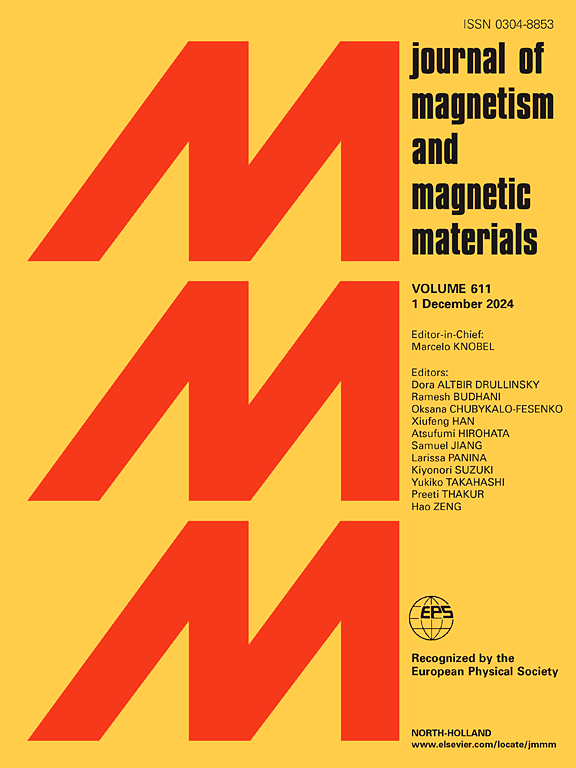Magnetoelectric coupling in solid solution of Ni3-xCoxTeO6 (0 ≤ x ≤ 2.85)
IF 2.5
3区 材料科学
Q3 MATERIALS SCIENCE, MULTIDISCIPLINARY
引用次数: 0
Abstract
We systematically investigate the structural, magnetic, and dielectric properties of polycrystalline samples Ni3-xCoxTeO6 (0 ≤ x ≤ 2.85). Powder X-ray diffraction reveals a structural transition from rhombohedral (R3) to monoclinic (C2/c) with increasing Co2+ substitution. The rhombohedral phase (R3) persists up to x ≤ 1.5, while x ∼ 2.55 and 2.85 adopt the monoclinic (C2/c) structure of Co3TeO6. Lattice parameters a and c increase linearly with Co2+ content, obeying Vegard’s law. The DC magnetic susceptibility, χ(T), study reveals long-range antiferromagnetic ordering at TN ∼ 53 K and weak ferro/ferrimagnetic ordering at Tc ∼ 82 K for lower Co2+ substitution. As Co2+ content increases, TN shifts to ∼49 K, and Tc disappears at the critical concentration. For x ∼ 2.55, χ(T) reveals multiple magnetic transitions: short-range order at Tm ∼ 50 K, a cusp at TN1 ∼ 32 K, TN2 ∼ 28.3 K, and an abrupt change at 21.8 K. For higher substitution (x ∼ 2.85), these transitions shift slightly to lower temperatures, Tm ∼ 49.3 and TN2 ∼ 26.2, resembling Co3TeO6 except for the presence of Tm. All the measured samples show dielectric peaks near magnetic transitions, suggesting a magneto-dielectric effect. Our results demonstrate that Co substitution in Ni3TeO6 tunes both magnetic and dielectric properties across the composition range. Notably, compositions such as NCTO3 (x = 0.45) exhibit pronounced dielectric anomalies coinciding with magnetic transitions, indicating a coupling between spin and dielectric responses. This behavior points to composition-sensitive magnetoelectric interactions, underscoring the potential for tuning multiferroic functionalities within the Ni3−xCoxTeO6 solid solution.
Ni3-xCoxTeO6固溶体中的磁电耦合(0≤x≤2.85)
我们系统地研究了Ni3-xCoxTeO6(0≤x≤2.85)多晶样品的结构、磁性和介电性能。粉末x射线衍射显示,随着Co2+取代量的增加,结构由菱形(R3)向单斜(C2/c)转变。菱面体相(R3)在x≤1.5时仍然存在,而x ~ 2.55和2.85采用Co3TeO6的单斜(C2/c)结构。晶格参数a和c随Co2+含量线性增加,符合维加德定律。直流磁化率χ(T)的研究表明,在TN ~ 53 K处的远程反铁磁有序,在Tc ~ 82 K处的弱铁/铁磁有序,以降低Co2+取代。随着Co2+含量的增加,TN向~ 49k偏移,Tc在临界浓度下消失。对于x ~ 2.55, χ(T)揭示了多重磁跃迁:在Tm ~ 50 K处有短程顺序,在TN1 ~ 32 K、TN2 ~ 28.3 K处有尖峰,在21.8 K处有突变。对于较高的取代(x ~ 2.85),这些转变稍微转移到较低的温度,Tm ~ 49.3和TN2 ~ 26.2,类似于Co3TeO6,除了Tm的存在。所有被测样品在磁跃迁附近都显示出介电峰,表明存在磁介电效应。我们的研究结果表明,Co取代Ni3TeO6在整个组成范围内都改变了磁性和介电性能。值得注意的是,NCTO3 (x = 0.45)等成分表现出明显的介电异常,与磁跃迁相吻合,表明自旋和介电响应之间存在耦合。这种行为指向了成分敏感的磁电相互作用,强调了在Ni3−xCoxTeO6固溶体中调整多铁性功能的潜力。
本文章由计算机程序翻译,如有差异,请以英文原文为准。
求助全文
约1分钟内获得全文
求助全文
来源期刊

Journal of Magnetism and Magnetic Materials
物理-材料科学:综合
CiteScore
5.30
自引率
11.10%
发文量
1149
审稿时长
59 days
期刊介绍:
The Journal of Magnetism and Magnetic Materials provides an important forum for the disclosure and discussion of original contributions covering the whole spectrum of topics, from basic magnetism to the technology and applications of magnetic materials. The journal encourages greater interaction between the basic and applied sub-disciplines of magnetism with comprehensive review articles, in addition to full-length contributions. In addition, other categories of contributions are welcome, including Critical Focused issues, Current Perspectives and Outreach to the General Public.
Main Categories:
Full-length articles:
Technically original research documents that report results of value to the communities that comprise the journal audience. The link between chemical, structural and microstructural properties on the one hand and magnetic properties on the other hand are encouraged.
In addition to general topics covering all areas of magnetism and magnetic materials, the full-length articles also include three sub-sections, focusing on Nanomagnetism, Spintronics and Applications.
The sub-section on Nanomagnetism contains articles on magnetic nanoparticles, nanowires, thin films, 2D materials and other nanoscale magnetic materials and their applications.
The sub-section on Spintronics contains articles on magnetoresistance, magnetoimpedance, magneto-optical phenomena, Micro-Electro-Mechanical Systems (MEMS), and other topics related to spin current control and magneto-transport phenomena. The sub-section on Applications display papers that focus on applications of magnetic materials. The applications need to show a connection to magnetism.
Review articles:
Review articles organize, clarify, and summarize existing major works in the areas covered by the Journal and provide comprehensive citations to the full spectrum of relevant literature.
 求助内容:
求助内容: 应助结果提醒方式:
应助结果提醒方式:


